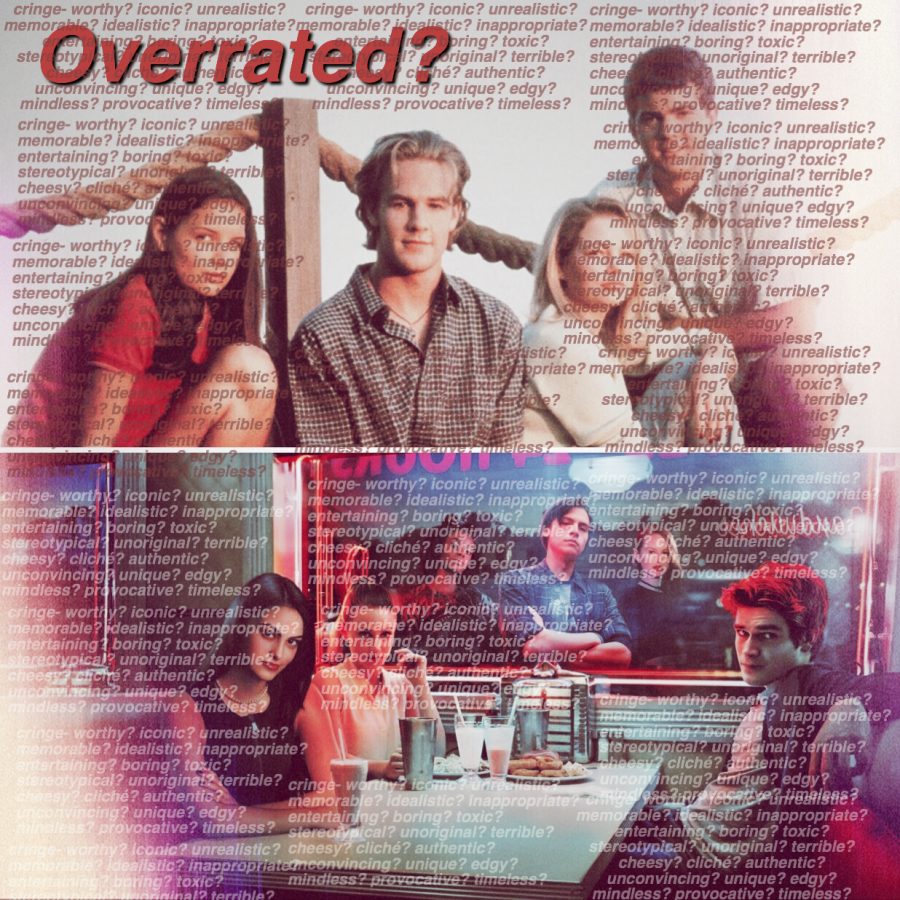20 years of trashy teen TV: Riverdale is the new Dawson’s Creek
courtesy of The Independent and Playbill
Nowadays, finding an entertaining show as a teen requires almost no effort. Social media only boosts the popularity of trending shows like Euphoria, 13 Reasons Why, and Stranger Things, causing large audiences to flock to streaming services such as Netflix, Hulu, and HBO GO. Never Too Young, the first soap opera geared specifically toward teenagers, premiered in 1965, starring Tony Dow from Leave it to Beaver and Thomas Rettig from the Lassie TV series. The show documented the daily lives of a group of teenagers who frequented a beach hangout called “The High Dive.” 50 years later, one could argue that this particular premise resembles several others that came after. Aside from the criticism they may receive for their inappropriate and controversial content, critics also call today’s teen shows unoriginal and unrealistic.
September 22, 2019
When it comes to creating hit teen dramas, producers stick to this golden rule: the less realistic, the higher the ratings. Soap operas made for and involving teenagers became popular in the late 1980s and early 1990s. Since then, soap opera’s ability to show viewers what not to do during their teen years and influence the way they dress, speak, and think made them an important part of pop culture. Whether watching out of control Upper-East Side socialites on Gossip Girl, small-town student-athletes on Friday Night Lights, or bloodthirsty, immortal teenage vampires on The Vampire Diaries, the escape that these highly entertaining yet unrealistic current soap operas provide distracts us from reality for an hour or two.
Riverdale, arguably one of the most popular drama shows amongst teens right now, will return to screens for its fourth season on October 5. The show puts a dark spin on the classic Archie comics series. Originally introduced in 1941, the comics chronicle the misadventures of all-American boy Archie Andrews, his perpetually hungry best friend Jughead, and his love triangle with Betty, the considerate girl-next-door, and Veronica, the shallow daughter of a millionaire. In the show, these characters reside in Riverdale, a small town shaken by the brutal murder of Jason Blossom, one of its most prominent youth.
Since Riverdale’s debut in early 2017, critics panned the show’s writing and acting. Following the premiere of season one, James Poniewozik of The New York Times called it “more an ensemble show than the story of Archie, which is fortunate, because here he’s written and played as a flat, brooding bore.”
The criticism and general dislike of Riverdale bears an uncanny resemblance to the media’s strong disapproval of Dawson’s Creek, a late ’90s/early 2000s teen drama that became widely known for its static and stereotypical characters, pretentious writing, and predictable plot. The show centered around 15-year-old aspiring filmmaker Dawson Leery and his friends as they grow up in the fictional town of Capeside, Massachusetts. Not only do Riverdale and Dawson’s Creek share pitfalls, they also share the same network, executive producer, and, upon further examination, they share similar plot lines and tropes. In March 1999, Anna Paul, a former staff member of The Chant, voiced her own opinions on Dawson’s Creek and the backlash it received.
“One of the WB’s newest darlings, Dawson’s Creek, is being blacklisted by critics everywhere. These critics are calling the show implausible, insipid and some are even going as far as to rate this sex-soaked teen soap as America’s #1 on the annual Dirty Dozen list of television shows”(Paul, 1999).
Our two main characters, Dawson and Archie, both lack dimension and serve primarily as eye candy. In a futile attempt to make them seem more unique, writers gave them unconventional hobbies: Dawson enjoys filmmaking, and Archie tries to juggle football practice with his budding music career. Still, teenage viewers fail to relate to either character because of how idealistic their lives seem. Dawson thinks of his life as a movie, and when things do not turn out the way he thinks they will, he throws a temper tantrum, criticizing everyone around him. A majority of the issues in Riverdale stem from Archie’s impulsiveness and arrogance.
Each main character on Dawson’s Creek has a counterpart on Riverdale. The type-A, female childhood friend (Joey/Betty) of the self-centered main character (Dawson/Archie) must watch as a beautiful girl from New York City with a mysterious past (Jen/Veronica) swoops in and steals the attention of the boy she secretly loves. Meanwhile, the drama drives a wedge between the main character and his troubled male best friend (Pacey/Jughead), and, because of their friend’s obsession with the new girl, the main character’s female and male best friend end up together.
Like other teen shows, the gang on Dawson’s Creek constantly discusses sex, garnering disapproval from parents and curiosity from adolescent viewers. The “ordinary” 15-year-olds in Capeside use a surprisingly vast vocabulary when exchanging views about this topic. For example, when he finds out that his mother cheated on his father, Dawson asks, “Is the proposition of monogamy such a Jurassic notion?” Similarly, the awkward dialogue and cringe-worthy lines in Riverdale warrant ridicule from its detractors, with quotes becoming popular internet memes. These “teen” characters act and look more like adults, making it hard for viewers to relate.
“The basic conversation in each episode is always based in some type of gutter-minded subject matter disguised by eloquent scholar-like diction and is never based in anything more enlightening or even humorous,” (Paul, 1999).
Just by watching the pilot episode of each show, the viewer will notice the use of the exact same sub-storyline—a teacher-student relationship. In Dawson’s Creek, Pacey successfully pursues his new English teacher, Ms. Jacobs, whereas, on Riverdale, Archie’s secret relationship with his music teacher Ms. Grundy makes him an initial person of interest in Jason Blossom’s murder case. One might call this a coincidence, but several teen dramas, recycled this scenario— Pretty Little Liars, One Tree Hill, Buffy The Vampire Slayer, and Gossip Girl (which used it two different times). This exposes teen shows’ lack of originality and carelessness on the part of the creators.
The unrealistic content on Dawson’s Creek and Riverdale can tarnish an adolescent’s thoughts about relationships, sex, and how to handle the difficult transition into adulthood. The surprising amount of similarities they share illustrates that producers do not put any effort into creating entertaining shows with fresh, new concepts for teens. Through the creation of this Dawson’s Creek copycat, they exposed a whole new generation to the same old toxic tropes and clichés. Teens want characters who look like them, act like them, and sound like them— adjusting any of these elements too drastically can decrease the entire show’s relatability. Teen dramas need diverse casts made up of convincing actors who not only entertain but positively influence their teenage audience.





